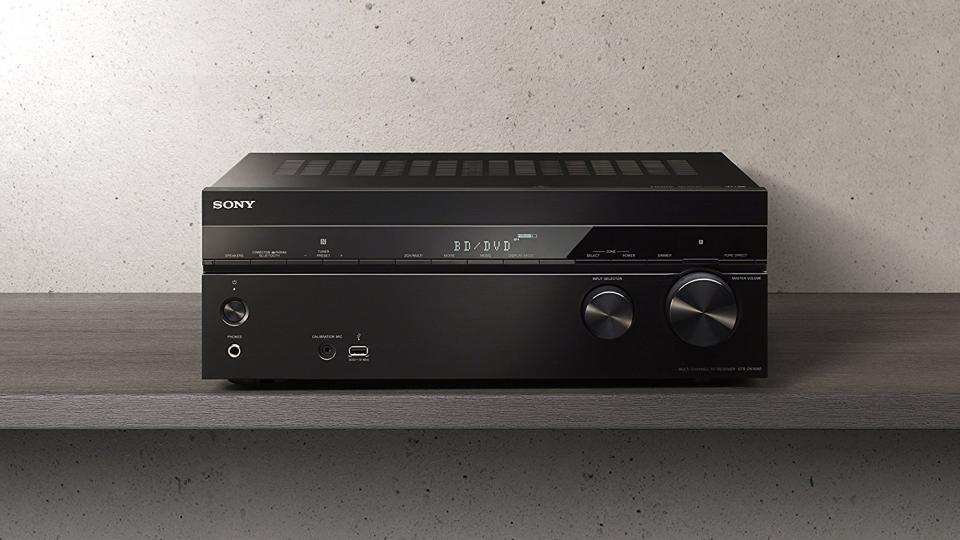
Soup up your sound system and create the ultimate home cinema with our pick of the best AV receivers
Today’s smart speakers and soundbars can pull off amazing feats of surround sound trickery, but the best AV receivers are still capable of so much more. For truly immersive home cinema, nothing beats a dedicated amplifier and a bundle of speakers. Movie soundtracks are carefully constructed to pull you into the story and make you feel like you’re right in the centre of the action, through a wide front soundstage, centred dialogue and deep low-frequency effects.
What’s more, the latest Dolby Atmos and DTS:X surround sound standards take things even further, creating a fully three-dimensional soundscape in which you can track individual objects as they move over and around you. These technologies aren’t only supported by blockbuster movies, but by the latest hit shows from Netflix, HBO, Amazon Prime Video and Disney Plus too. Even some music is now being mixed or remastered to take advantage.
The AV Receiver (AVR) is the foundation of any great home cinema system, not only processing surround sound data and powering the speakers, but acting as a switching hub for all your AV sources: Blu-ray players, set-top-boxes, media streamers and games consoles. Increasingly, many will also function as part of a multiroom Wi-Fi audio system. That means you can stream audio from Spotify through to your AVR, then shift it to a speaker in the bedroom, or sync the sound from a TV show with a speaker in your kitchen.
However, AVRs can cost anywhere between £200 and £3,000 or more, with varying features, designs and levels of audiophile sound quality. So which AVR is best for you? Our in-depth buying guide will show you what you need to look out for and help you decide how much to spend.
Editor’s picks
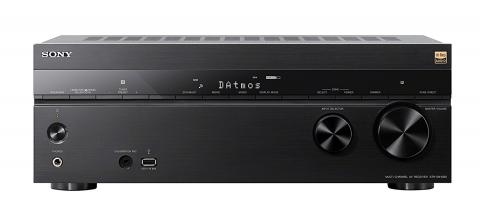
Sony STR-DN1080: The best value Dolby Atmos AV receiver
Sony’s Sony STR-DN1080 strikes the perfect balance between price and performance. There are six HDMI inputs and two outs, plus two digital inputs and three analogue AV inputs. Its secret weapon is phantom imaging, which allows it to create an additional rear surround sound channel where one does not exist. Amazon £429 Buy Now
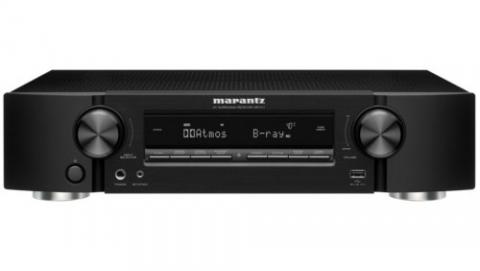
Marantz NR-1711: The future-proof, slimline AVR
The Marantz NR-1711 packs a lot of AV tech into a slimline package, with support for 8K resolutions, 120Hz refresh rates, all the major HDR standards and Dolby Atmos and DTS:X. Just as importantly, it sounds fantastic, combining warm and nuance in music with impact and authority in movie soundtracks. It’s the compact AVR that does it all. Electric Shop £649 Buy Now
How to choose the best AV receiver for you
While all AV receivers share the same basic functionality, they vary dramatically in specification and performance. What’s best for you depends on your existing (and planned) system requirements and also the room you’re going to use it in – a small living space probably doesn’t need a 7x200W powerhouse pumping away (although that would be fun).
How much should I spend on an AV receiver?
Break down what you need and decide on a budget. One fundamental aspect of any AV receiver is the number of HDMI inputs on offer. Entry-level models will most likely have four, while higher-end models will at least double that. More is always best. But remember, all modern AV receivers support ARC (Audio Return Channel) over HDMI, so if you have three more sources connected directly to the HDMI inputs on your TV, all can play through your AV receiver using ARC (provided your telly also supports the connection).
The crucial thing – particularly if you want to future-proof your setup – is to make sure that the HDMI inputs on your shortlisted receiver support HDCP 2.2 (the copy protection protocol used by all 4K video sources) and 4K, HDR video at 60Hz. Most ports that support the HDMI 2.0a standard should fit the bill. However, the gold standard going forward is HDMI 2.1, which supports higher resolutions and faster refresh rates – 4K UHD at 120Hz and the new 8K resolution at 60Hz – plus Dynamic HDR and eARC. eARC is an enhanced version of ARC that supports more advanced audio formats.
HDMI 2.1 also supports a range of technologies that are useful for next-generation game consoles, including Variable Refresh Rate (VRR), which prevents the screen-tearing effects you sometimes see when games can’t match the refresh rate of the screen, and Quick Frame Transport (QFT) and Auto Low Latency Mode (ALLM), both of which can help kill lag when playing games.
Don’t forget to check the number of HDMI outputs too. If a receiver has two, you can connect both a TV and a projector.
Do I need Dolby Atmos or is regular 5.1 surround sound good enough?
Entry-level Dolby Atmos AV receivers typically have seven channels of amplification: five for standard left/centre/right and two rear speakers for surround sound, plus two for height duties. This is known as a 5.1.2 layout (the .1 is the dedicated subwoofer channel). Higher-end AV receivers may offer nine or even eleven channels of amplification, increasing the number of height and rear options (so 5.1.4 or 7.1.4).
With some amplifiers you don’t necessarily need dedicated height speakers, as they can use some clever processing trickery to simulate height effects using an existing 5.1 or 7.1 setup. These virtual height setups can be surprisingly effective, though nothing beats a full speaker setup for delivering a completely immersive and coherent 3D soundscape.
Increasingly, only entry-level AVRs come without Atmos support – and they can still deliver incredible 5.1 surround sound. But with the quality of the virtual setups so good, we reckon Atmos is worth the step upwards even if you can’t house a full 5.1.2 or 7.1.2 setup in your lounge. You’ll find programmes and films with Atmos audio tracks on Netflix, Amazon Prime Video and Disney Plus, not to mention a growing number of 4K Blu-ray releases.
It’s also worth noting that Dolby’s old rival, DTS, has its own alternative to Atmos called DTS:X. DTS:X can also adapt to a range of different speaker setups, using processing to create virtual speakers where required. It’s used extensively in cinemas and has moved into home AVRs. All the same, DTS:X isn’t as widely supported as Atmos; you’ll find it on some 4K Blu-ray discs but not on any major streaming services, which means it’s more of a nice-to-have than an absolute must.
How important is power? How many watts per channel do I need?
Manufacturers often play Top Trumps when it comes to power output, but the numbers are hardly ever comparable, thanks to measuring methodologies. We quote them purely as a reference, but our advice is to take them here with a pinch of salt. A high-quality 50W amplifier will nearly always sound better than a poor 100W amplifier driven at volume.
Can AV amplifiers form part of a multiroom system?
They sure can. If you have already invested in a multiroom wireless audio system, it makes sense to buy a compatible AV receiver that works in tandem. For example, if you have Yamaha MusicCast speakers already then a Yamaha MusicCast AV receiver would make perfect sense. The same goes for Google Chromecast multiroom and Heos.
READ NEXT: The best 4K HDR TVs out right now
The best AV receivers to buy
1. Sony STR-DH790: The best entry-level AVR
Price: £299 | Buy now from Amazon
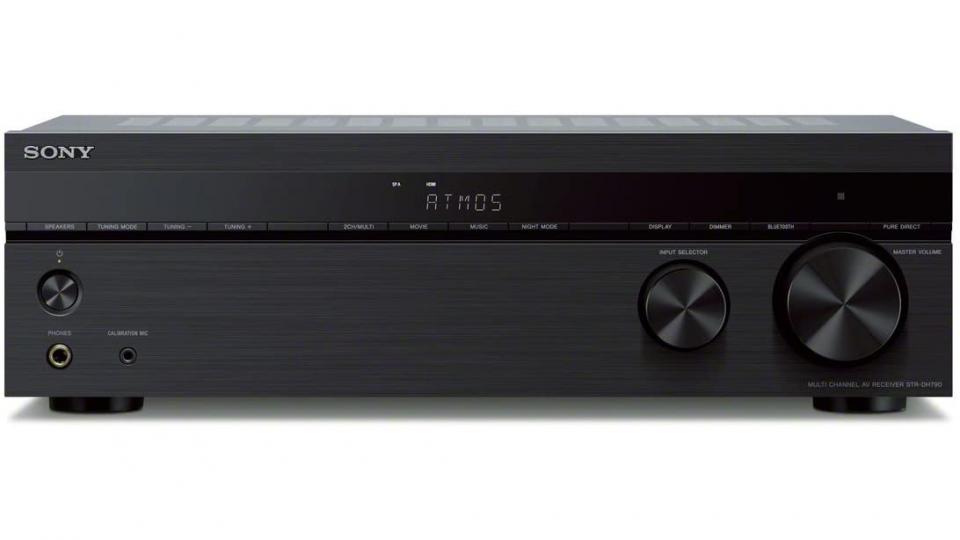
The SRT-DH790 feels like a cut-down STR-DN1080 in more ways than one; sitting just over an inch lower than its bigger brother, it’ll be an easier fit into many AV setups. Otherwise, the crucial differences include a lower power output (145W to 165W), fewer HDMI inputs and outputs (4 and 1 instead of 6 and 2) and the use of spring clip terminals for the centre, surround and rear/height speakers instead of the more versatile banana plug sockets. There’s also no built-in networking support. In short, we get the kind of cutbacks you might expect for an entry-level amp.
What’s more interesting is what you’ve still got, with support for 4K HDR video and Dolby Vision plus Dolby Atmos and DTS: X. Auto-calibration makes setup easy, and it’ll handle speaker configurations ranging from a stereo setup (using Sony’s S-Force virtual surround) to 5.1.2 and 7.1 surround. Sound isn’t quite in the same class as the STR-DN1080, but it’s a big step on from what you’d get from a soundbar or older 5.1 setup, with convincing Atmos effects on demos and movie soundtracks. Spend more money and you’ll get more future-proofing and high-end features, but this is a solid foundation for a great 4K home cinema setup.
Key specs – Dolby Atmos: Yes, 5.1.2; Power output: 7 x 145W; HDMIs: 4-in 1-out; Dimensions: 430 x 297 x 133mm (WDH); Weight: 7.4kg
2. Sony STR-DN1080: The best value Dolby Atmos AV receiver
Price: £429 | Buy now from Amazon
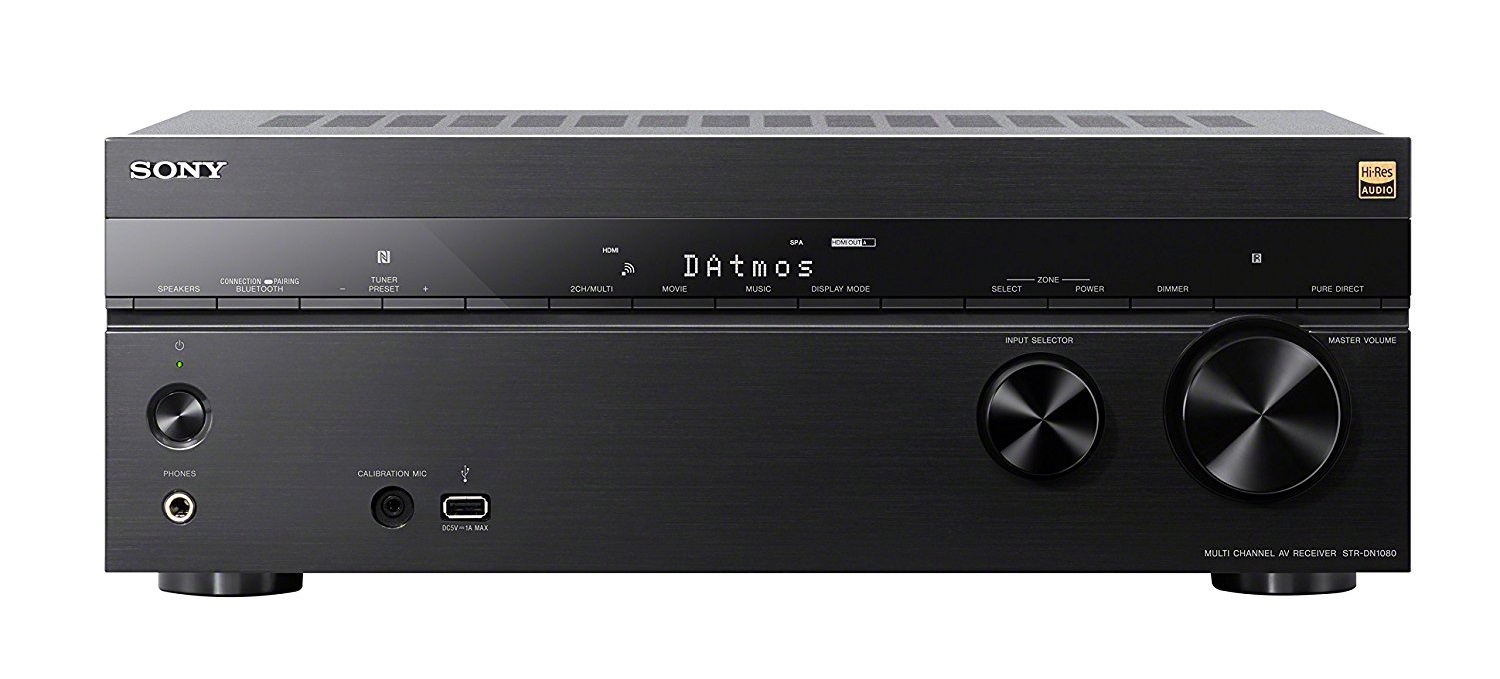
Do you believe in phantoms? You will, after listening to this impressive Sony Dolby Atmos model. That’s because it uses phantom imaging to create a rear surround channel, giving a 6.1.2 listening experience from just seven speakers. The psycho-acoustic DSP effect places audio behind your head. Even better, this Sony has powerful Speaker Relocation processing and A.P.M phase frequency adjustment to virtually re-orientate your speakers if they’re not in optimum surround positions. Science or magic? We’re not sure.
The feature specification is impressive, with Bluetooth headphone pairing joining Wi-Fi and Chromecast support. Connectivity includes six HDMI inputs and two outs, plus two digital inputs and three analogue AV inputs. There’s no HDMI 2.1 support, meaning no support for 8K resolutions, 120Hz refresh rates or VRR, but unless you’re investing in a next-gen games console or an 8K TV, this isn’t what you’d call a dealbreaker, and will doubtless be fixed in Sony’s next mid-range AVR.
Sonically, this receiver isn’t what you’d describe as warm. It’s analytical and sharp, but if you like detail (and who doesn’t?), it’s a lot of fun to listen too. With action blockbusters, it’ll engulf you with sound, and it can drop deep bass when it needs it.
Key specs – Dolby Atmos: Yes, 5.1.2; Power output: 7 x 165W; HDMIs: 6-in 2-out; Dimensions: 430 x 331 x 156mm (WDH); Weight: 9.7kg

Sony STRDN1080.CEK 7.2 CH 4K UHD AV Receiver with Dolby Atmos and Multi-Room – Black
£429.00 Buy now
3. Denon AVR-X2700H: The best mid-range Atmos receiver
Price: £599 | Buy now from Electric Shop
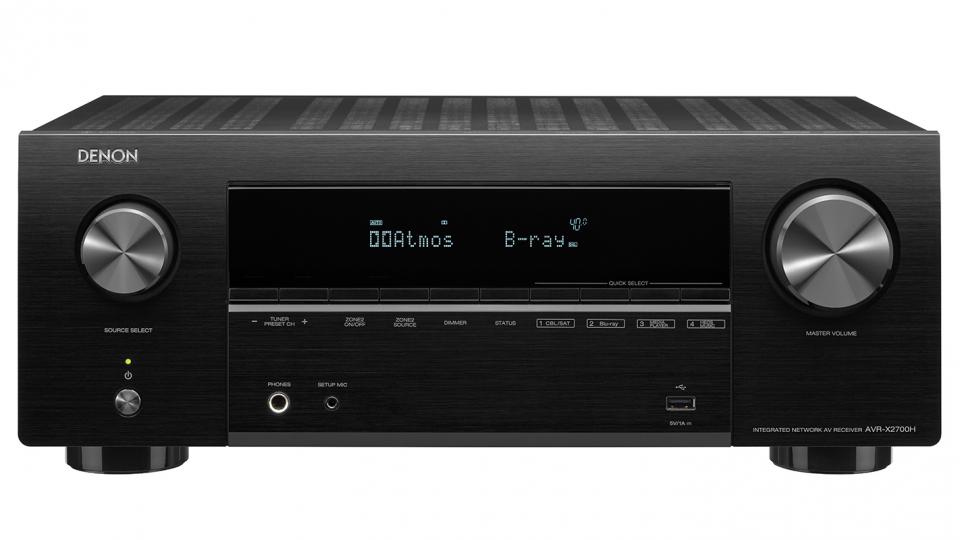
With support for 8K screens and video sources, 4K at 120fps and variable refresh rate, the Denon AVR-X2700H is ready for anything the future might throw at it, including the PlayStation 5 and Xbox Series X consoles or 8K streaming services. Only one of the ports is HDMI 2.1 certified, but the others still support VRR, ALLM and QFT, while the HDMI outputs support eARC. With Dolby Atmos (including Atmos Height Virtualization), DTS:X (with DTS Virtual:X) and all four major HDR formats also covered, there’s very little that this AVR won’t play with.
Just as importantly, it makes all this seem easy, thanks to Denon’s superb auto-calibration process, which configures your speakers and sets the levels for you, and a very straightforward interface you can use on your TV.
Feed it some good material, and you’ll be amazed at the sound produced. Switch from 4K Blu-rays like Blade Runner 2049 and Avengers: Endgame to Star Wars: Rise of the Skywalker on Disney+, and there’s a real authority to output and fantastic, precise steering of sound effects, putting you right in the centre of the action. You won’t get a better experience of Hamilton on Disney+ without sitting in the theatre. The virtual speaker effects are convincing enough that you don’t desperately need Atmos speakers, though the output is even more convincing with at least one set plugged in.
Music sounds great as well, though it’s worth switching through the different sound modes to find what works best in your room. Throw built-in Wi-Fi music streaming and multi-room features, controlled through Denon’s HEOS app, and you have a fantastic AVR that will support your home cinema for years to come.
Key specs – Dolby Atmos: Yes, 5.1.2; Power output: 7 x 150W; HDMIs: 6-in 2-out; Dimensions: 433 x 330 x 167mm (WDH); Weight: 9.5kg
4. Marantz NR-1711: The best slimline AV
Price: £649 | Buy now from Electric Shop
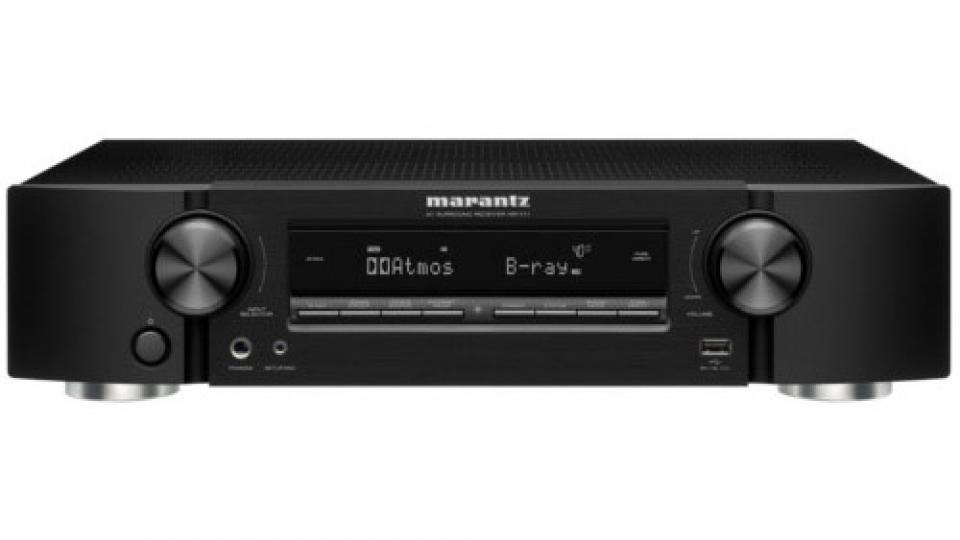
The Marantz NR-1711 shares many of the same advantages of the Denon AVR-X2700H, only packed into a much more compact chassis standing just over 10cm high. One of the HDMI inputs supports 8K at 60Hz or 4K at 120Hz, along with VRR, ALLM and QFT. Meanwhile, the HDMI out supports all that along with eARC. Throw in HDR10, HDR10+, HLG and Dolby Vision and you’ve got an amp that should have all your AV needs covered for the next decade.
The advantage with this one is that it’s a very easy AVR to work with – slim enough to fit into most setups and very easy to set-up. While it’s at its best with a full 5.1.2 Atmos setup, it works brilliantly with a more basic 5.1 setup, thanks to some exceptionally good height virtualization, and the Audyssey auto-configuration process works as well here as it does on the AVR-X2700H.
In terms of performance, the NR-1711 is limited to 90W per channel, but you’d be hard pressed to find its limits unless you were trying to fill a particularly cavernous space. Across 4K Blu-ray movies, Xbox One X games and Atmos streaming content, the sound is incredibly absorbing, detail-rich and energetic. But the NR-1711 is also a superb AVR for music, handling high-resolution material from streaming services with vibrancy and warmth, making for some fantastic listening.
Like the AVR-X2700H, it has built-in Wi-Fi networking and support for Denon’s HEOS ecosystem for streaming and multiroom control. It’s the kind of amp that would be perfect at powering a compact speaker system, but don’t rule it out if you’ve got a larger living room – it’s the king of the slimline AVRs.
Key specs – Dolby Atmos: Yes, 5.1.2; Power output: 7 x 90W; HDMIs: 6-in 1-out; Dimensions: 440 x 378 x 105mm (WDH); Weight: 8.3kg

